|
|
|
|
Lesson 4 |
The 17th century: Scientific Revolution. Circulation of the Blood. The Doctrine of Contagion. Witch Hunting. |
|
|
|
|
|
|
|
Fabrizio Hildanus (1545-1599)asserted that pus must not enter the wound, and that before operating, a ligature must be applied to the vessels. Gaspare Tagliacozzo (1545-1599) learnt the method of nose reconstruction from the "Norcini" who operated in southern Italy. Nasal reconstruction was important given that nose was destroyed by many diseases such as tuberculosis and syphilis, as well as because of the very frequent mutilations caused by firearms.
His most important contribution to science was certainly the use of mathematics, necessary to quantify experiments. Because Galileo was a physicist, he elaborated a theory according to which the body was a machine and the organs were smaller or minute machines, moreover, he had to research the elementary machine. Galileo's microscopes had great problems because they refracted and reflected the light so much that many illusory images were seen: this brought strong criticism of the microscope. Marco Aurelio Severino (1580-1656) was born in Tarsia, Calabria, and lived in Naples where he was Professor of Anatomy and Medicine. He fully embraced Galileo's philosophy and by using the microscope he described the uterus of the beetle (which it does not possess, naturally). All the same he demonstrated that the insects have organs which are found in the higher orders of animals. He also felt the microscope had to be used in order to see invisible things and that anatomy must not be considered as the "art of dissection" but must serve to uncover and research into atoms (Anatomia dissutrix non dissectrix) . Severino was also a great surgeon and the author (1632) of the first illustrated textbook on surgical pathology. In Naples there was an epidemic of diphtheria and he performed laryngectomy thereby saving many lives. During the plague he did not flee the city, as many other doctors did, but remained to care for sick persons. However, unfortunately, he succumbed to and died of plague. The studies of insects using the microscope proved that things that seemed to be absolutely simple were, in fact, very complicated. Some of the students of the school of Galileo used clever devices in order to disclose hidden structures, thereby creating the so called "artificial" anatomy. For example, at Palermo Giovanbattista Odierna (1597-1660) by boiling the eye of a fly proved that it was made of a chrystalline myriad which allowed the insect to have 360° vision. Besides the microscope, the micoscopius naturae (the microscope of nature) could be used. In fact, Auberius, who was a student of Giovanni Alfonso Borelli (1608-1679) , who himself was one of Galileo's students, in order to show how the testicle is made, studied the much bigger testis of pig, the animal which had previously struck Galen because its organs were similar to those of man. Auberius discovered the seminoferous tubules, the structure of the efferent canals and the epididymis, which were then compared to those of man. Therefore, any method was in order to understand how the human body is constructed and works. The fact that Galilean science was based on experiment and that significance could be given to findings only after having been observed and measured, brought consequences that were at times at the limit of the possible. For example, the great scientist Sanctorius Sanctorius (1561-1636) , who hailed from Istria and was a pupil of the Galilean school, spent a large part of his life in a weighing machine in which he weighed himself when he ate and after he defecated, measuring what was left after he had eaten: he thus gained an intuition about metabolism. He also understood that sweating served to eliminate heat. He was also the first to measure the pulse and to use a thermometer to measure body temperature.
1628: this is the historical date in which Harvey published his tract entitled Exercitatio Anatomica de Motu Cordis et Sanguinis in Animalibus. Harvey, using the same plate as Fabricius ab Aquapendente, demonstrated that the blood in the veins did not have centrifugal flow, as reported by Galen, according to whom blood went from the liver to the periphery. Fabricius had interpreted those swellings (due to the venous valves, that can be seen when a vein is compressed) as The new theory had several supporters, but also many critics, wheras the concept of circulation was associated with a political idea on the circulation of power. Although Harvey was initially much criticised, the theory was later accepted, resulting in the liver being declassified as the principal organ, its function being reduced to bile secretion. Furthermore, a famous anatomist Thomas Bartholin (who was also Stensen's teacher) published the exequiae(exequies) on the liver.
The Problem of Contagion
Sardinia is a typical example of how diseases such as plague took root in the city, but seldom in the villages. The vehicle causing plague is the flea. In fact, it is the rat on which the flea lives which falls ill with the plague, and then the flea transmits the plague to human beings, after which, the plague becomes a pulmonary disease meaning that the contagion goes directly from man to man. The plague came from the Orient, and it seems that it may have been brought to Messina by a Genoese ship which had escaped from a city that was being besieged by the Turks. The Turks had thrown corpses of the plague's dead victims into the city, so some sailors fell ill and brought the disease to Messina from where it spread throughout Italy, and then throughout all Europe. The later disappearance of plague was favoured by the fact that around the end of 17th century there was an invasion of brown rats which supplanted the black rat, which is much more receptive to the plague, and also because wooden floors in which the rats could live stopped being built (above all this happened in places with hot climates). Another hypothesis maintained that this was due to the appearance of a less virulent germ, which caused the immunisation of rats. Almost contemporaneously with the publication of the work of Andreas Vesalius, there was a famous Veronese medical anatomist Hieronymus Fracastoro (1478/9-1553) , who named an endemic disease which had already developed: syphilis. First page of Gerolamo Fracastoro poem on syphilisSyphilis broke out for the first time in an epidemic fashion during the 1496 siege of Naples by Carlo VIII, king of France. Until Italy was a leading nation, syphilis was called 'French disease', but when Italy declined, the French appellation: 'Neapolitan illness' prevailed.
Fracastoro named the disease "syphilis" in a famous little poem dedicated to Pietro Bembo. In it he also spoke of the legno santo (holy wood) which was one of the principal therapies at the time: it was believed that this particular resin, guiacum, which caused profuse sweating and drooling, cured syphilis because, according to Hippocratic principles, it eliminated the materia peccans. The excess of phlegm, at the origin of the disease, had to be removed by using pharmaceutical drugs which caused sweating and drooling, such as the guiacum, and also mercury. Syphilis, it was a disease which made the fortune of many physicians because in 30% of the cases it healed itself. When a person recovered from an illness, the doctor maintained that it was because of the effectiveness of his cure, although of course this was not really the case. To fight syphilis, mercury was administered, which, being toxic for the sudoriferous and salivary glands, caused a very potent secretion. At that time the treatment proposed to avoid sweating and drooling was to place an incandescent iron bar on the patient's head since it was believed, as we have seen, that saliva and sweat came from the brain. Mercury also made teeth turn black, forcing noble women to file their teeth in order to hide the fact that they were undergoing the mercury therapy against syphilis. Fracastoro believed that invisible living organisms existed which spread the plague. These he called 'seminaria' which can best be translated as 'seeds' and can be thought of as being akin to bacteria or virus. These 'seminaria' could be transmitted not only by direct contact but also through clothes, sheets, and objects. Another endemic illness frequent at that time was leprosy. Leprosy in Sardinia took root especially in villages because it is an illness whose incubation is very slow. Leprosy is quite similar to tuberculosis and the two micro-organisms are rivals for, where there is leprosy, there is no tuberculosis and vice versa. Till a few years ago, there were many leprosy hotbeds in Sardinia. To contract leprosy, prolonged contagion is necessary for the infection to take root, therefore it is unlikely that a person who travels a lot would contract it. Leprosy was an illness to be feared, having rather particular social implications. In fact, when it was discovered that someone had leprosy (at the end of Medieval times and the beginning of modern times) a funeral was arranged and the poor fellow lost all his rights. However, since lepers were kept in isolation at the community's expense, poverty-stricken people declared themselves to be lepers in order to survive through receiving this form of social security. The infamous practice of witch hunting started between the end of the XIV century in the Christian world, both among Catholics and Protestants. The criteria useful to detect witchcraft and to persecute witches as heretics, were detailed in the notorious: Malleus Maleficarum a textbook authored in the XV century by two fanatic German Dominican monks: Jakob Sprenger and Heirich Institor Kramer, which had, for the time, an enormous circulation (34 editions with more than 30000 copies). Witch hunting took place particularly between the end of 1400 and the first half of 1600. The alleged witches belonged to common people and were usually widows or single women, midwifes, herbalists, sorceresses or prostitutes. Many “witches” were subjected to horrible torments and burned alive. Their “confessions”, wringed by torture, were used as evidence to indict other unfortunate women. As a rule the practice, with some exceptions, was limited to the female sex. The last trials for witchcraft where the “witches” were sentenced and burned alive, took place in Protestant Switzerland in 1782, and in Catholic Poland in 1793. |
|
|
From the notes of Mario D'Atri |
 Tagliacozzo's method was to take a skin graft from the arm and use it to reconstruct the nose. He became famous throughout Europe and people came from all over to be cured by him. After his death, his work was continued by a student, but not for very long. In fact, the Counter-reformation, which was characterised by the stiffening of Catholic morals, forbade the intervention because reconstruction of body parts was a prerogative of God. So Tagliacozzo's corpse was exhumed from the consecrated cemetery and reburied in an deconsecrated area, while the student was imprisoned. However, the memory of his work survived, thanks his treatise on plastic surgery (DE CHIRURGIA CURTORUM). Plastic surgery was rediscovered only in the 19th century at the time when the Indian system of plastic surgery was in use, which was simpler, but also much more disfiguring. This consisted of taking a piece of skin from the forehead and placing it on the nose.
Tagliacozzo's method was to take a skin graft from the arm and use it to reconstruct the nose. He became famous throughout Europe and people came from all over to be cured by him. After his death, his work was continued by a student, but not for very long. In fact, the Counter-reformation, which was characterised by the stiffening of Catholic morals, forbade the intervention because reconstruction of body parts was a prerogative of God. So Tagliacozzo's corpse was exhumed from the consecrated cemetery and reburied in an deconsecrated area, while the student was imprisoned. However, the memory of his work survived, thanks his treatise on plastic surgery (DE CHIRURGIA CURTORUM). Plastic surgery was rediscovered only in the 19th century at the time when the Indian system of plastic surgery was in use, which was simpler, but also much more disfiguring. This consisted of taking a piece of skin from the forehead and placing it on the nose. 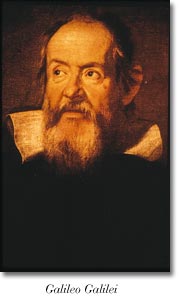 The end of the 16th century and the 17th century were characterised by the scientific revolution largely brought about by Galileo Galilei (1564-1642). He was the son of a famous Pisan musician and his father wanted to make of him a physician, but he, instead, became interested in mathematics. He was the first to introduce mathematics into scientific experiments. Galileo embraced Democritus' theories in opposition to those of Aristotle who had believed that everything that occurred in nature has a purpose. Democritus maintained that the universe and its organisms are formed by atoms in a continuous and casual movement. Democritus' philosophy was therefore based on observation, and not on finalism as was that of Aristotle: on how, not on why.
The end of the 16th century and the 17th century were characterised by the scientific revolution largely brought about by Galileo Galilei (1564-1642). He was the son of a famous Pisan musician and his father wanted to make of him a physician, but he, instead, became interested in mathematics. He was the first to introduce mathematics into scientific experiments. Galileo embraced Democritus' theories in opposition to those of Aristotle who had believed that everything that occurred in nature has a purpose. Democritus maintained that the universe and its organisms are formed by atoms in a continuous and casual movement. Democritus' philosophy was therefore based on observation, and not on finalism as was that of Aristotle: on how, not on why. 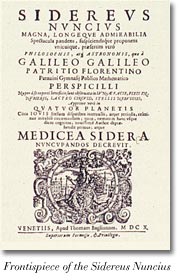 In the Sidereus Nuncius Galileo asserted that he had managed to demonstrate the theory of Copernicus experimentally. In fact, using the telescope he discovered the three satellites of Jupiter and demonstrated that the sun was at the centre of the universe, not the earth, thereby proving that the theory of Tolemy was false. Upon producing this evidence, Galileo had great problems with the Inquisition. When he left Padua, where he taught at the university, he made the mistake of going to Florence, a city that was very close to the Pope unlike Venice which still enjoyed a certain degree of autonomy because of its political strength and its distance from Rome. So, despite his friendship with the ruling Medici family, he was persecuted by the Inquisition. Galileo also had the insight of not only using the telescope to see the planets, but also to use lenses to investigate the small things of this world, and advised his students to do so. It was one of his pupils, Francesco Stelluti (1577-1652) , who named the instrument a microscope and published (1630) the first pictures of insects as seen under the microscope. There is a tradition without any historical basis that a Dutchman Zacharius Jansen discovered the microscope. In fact, the only certain thing is that he made lenses. The use of the microscope to observe invisible things can be attributed only to Galileo. In one of his letters dated 1624 he exhorts his students to use the microscope.
In the Sidereus Nuncius Galileo asserted that he had managed to demonstrate the theory of Copernicus experimentally. In fact, using the telescope he discovered the three satellites of Jupiter and demonstrated that the sun was at the centre of the universe, not the earth, thereby proving that the theory of Tolemy was false. Upon producing this evidence, Galileo had great problems with the Inquisition. When he left Padua, where he taught at the university, he made the mistake of going to Florence, a city that was very close to the Pope unlike Venice which still enjoyed a certain degree of autonomy because of its political strength and its distance from Rome. So, despite his friendship with the ruling Medici family, he was persecuted by the Inquisition. Galileo also had the insight of not only using the telescope to see the planets, but also to use lenses to investigate the small things of this world, and advised his students to do so. It was one of his pupils, Francesco Stelluti (1577-1652) , who named the instrument a microscope and published (1630) the first pictures of insects as seen under the microscope. There is a tradition without any historical basis that a Dutchman Zacharius Jansen discovered the microscope. In fact, the only certain thing is that he made lenses. The use of the microscope to observe invisible things can be attributed only to Galileo. In one of his letters dated 1624 he exhorts his students to use the microscope. 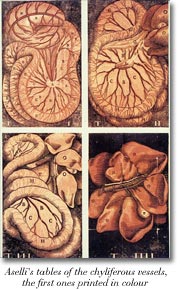 Gaspare Aselli (1581-1626) was a doctor in Milan and a also a professor at the University of Pavia (at the time there was no University at Milan) who discovered the chyliferous vessels. While carrying out an experiment on a small dog in which he wanted to show how diaphragmatic excursions happened and also how they could be stopped with the resection of the phrenic nerve, he saw in opened abdomen, under the diaphragm, an extremely white network in the mesh of the mesentery and thought that he had made a great discovery, that is to say, had discovered the fourth type of circulation. When he tried to repeat the discovery at the University of Pavia he used very large dog, but after having opened it in front of everyone he could not see anything. So Aselli, after a moment of uncomfortable reflection, thought that the difference between the two dogs was that one had eaten while the second dog, which was a stray, had fasted. So he decided to repeat the experiment with a third dog, which he opened after having made it eat. Finally, this time he could see the network of chyliferous veins and was able to demonstrate their existence to his colleagues. Following this, he published an atlas which contained the first prints in colour. A great error made by Aselli was that he confused a lymph node with an organ that was called the pancreas of Aselli. The lymphatic system was still not yet known, and was discovered only some decades later: first Jean Pequet (1622-1674) discovered the chyle cystern, and, then, the whole lymphatic circulation was described by a Roman physician Giovanni Guglielmo Riva (1627-1677) , and by the Danish Thomas Bartholin (1616-1680) . It should be remembered that Bartolomeo Eustachi had already described the thoracic duct of the horse in 1564.
Gaspare Aselli (1581-1626) was a doctor in Milan and a also a professor at the University of Pavia (at the time there was no University at Milan) who discovered the chyliferous vessels. While carrying out an experiment on a small dog in which he wanted to show how diaphragmatic excursions happened and also how they could be stopped with the resection of the phrenic nerve, he saw in opened abdomen, under the diaphragm, an extremely white network in the mesh of the mesentery and thought that he had made a great discovery, that is to say, had discovered the fourth type of circulation. When he tried to repeat the discovery at the University of Pavia he used very large dog, but after having opened it in front of everyone he could not see anything. So Aselli, after a moment of uncomfortable reflection, thought that the difference between the two dogs was that one had eaten while the second dog, which was a stray, had fasted. So he decided to repeat the experiment with a third dog, which he opened after having made it eat. Finally, this time he could see the network of chyliferous veins and was able to demonstrate their existence to his colleagues. Following this, he published an atlas which contained the first prints in colour. A great error made by Aselli was that he confused a lymph node with an organ that was called the pancreas of Aselli. The lymphatic system was still not yet known, and was discovered only some decades later: first Jean Pequet (1622-1674) discovered the chyle cystern, and, then, the whole lymphatic circulation was described by a Roman physician Giovanni Guglielmo Riva (1627-1677) , and by the Danish Thomas Bartholin (1616-1680) . It should be remembered that Bartolomeo Eustachi had already described the thoracic duct of the horse in 1564. 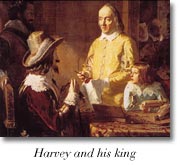 William Harvey (1578-1657) studied at Padua where he was a pupil of both Fabricius and Casserius. He was interested in the circulation of the blood. He started by measuring the quantity of blood in the body of an animal (he took an animal and cut a vein in order to extract all the blood) and saw that its quantity was limited. This fact contrasted with the concept of Galen according to which blood was produced continuously in order for it to be absorbed by the peripheral structures.
William Harvey (1578-1657) studied at Padua where he was a pupil of both Fabricius and Casserius. He was interested in the circulation of the blood. He started by measuring the quantity of blood in the body of an animal (he took an animal and cut a vein in order to extract all the blood) and saw that its quantity was limited. This fact contrasted with the concept of Galen according to which blood was produced continuously in order for it to be absorbed by the peripheral structures. 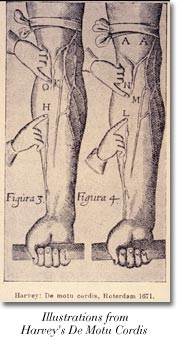 small gates that served to slow down the flow from the centre to the periphery. Harvey demonstrated the exact opposite: in fact when he placed a loop around a vein he observed that it became turgid and then on closing another two segments he noticed that the blood did not go from the centre to the periphery, but from the periphery towards the centre. Therefore, Harvey understood the mechanism of venous circulation, and postulated that the heart is a pump which makes the blood circulate from the arteries to the veins. He could not, however , demonstrate the nexus between the arteries and the veins because he was not able to see the capillaries with the naked eye. The capillaries were later discovered using the microscope by Malpighi in cold blooded animals, and by William Cowper (1666-1709) and by Spallanzani in the warm blooded ones.
small gates that served to slow down the flow from the centre to the periphery. Harvey demonstrated the exact opposite: in fact when he placed a loop around a vein he observed that it became turgid and then on closing another two segments he noticed that the blood did not go from the centre to the periphery, but from the periphery towards the centre. Therefore, Harvey understood the mechanism of venous circulation, and postulated that the heart is a pump which makes the blood circulate from the arteries to the veins. He could not, however , demonstrate the nexus between the arteries and the veins because he was not able to see the capillaries with the naked eye. The capillaries were later discovered using the microscope by Malpighi in cold blooded animals, and by William Cowper (1666-1709) and by Spallanzani in the warm blooded ones. 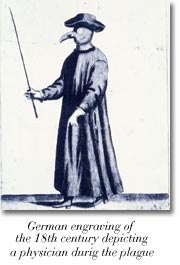 Notwithstanding the fact that there had been plague in the 14th and in 17th century, and notwithstanding the fact that there were a great many endemic illness such as leprosy and tuberculosis, the concept of contagion through living organisms (live contagion) did not develop. In practice, it was not understood how the diseases were transmitted: the most accredited idea was that smells (miasmas) carried the contagion, but they did not really understand how and why this occurred. There was absolutely no concept of hygiene, the patients were placed on dirty beds with sheets which were recycled and never washed. This lead to the spread of the diseases, especially in the most populous areas.
Notwithstanding the fact that there had been plague in the 14th and in 17th century, and notwithstanding the fact that there were a great many endemic illness such as leprosy and tuberculosis, the concept of contagion through living organisms (live contagion) did not develop. In practice, it was not understood how the diseases were transmitted: the most accredited idea was that smells (miasmas) carried the contagion, but they did not really understand how and why this occurred. There was absolutely no concept of hygiene, the patients were placed on dirty beds with sheets which were recycled and never washed. This lead to the spread of the diseases, especially in the most populous areas. 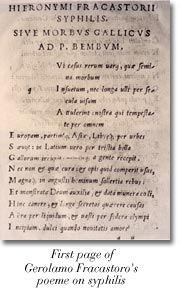 Syphilis may have been caused by the recrudescence of an illness which had altered its physiognomy and that was already endemic in the Arab world to the east. Another theory was that it was carried from America by Christopher Columbus's sailors. At any rate it was understood from the beginning that syphilis is spread by sexual contact. In fact, it was said that the disease had developed from the union of a prostitute with a leper.
Syphilis may have been caused by the recrudescence of an illness which had altered its physiognomy and that was already endemic in the Arab world to the east. Another theory was that it was carried from America by Christopher Columbus's sailors. At any rate it was understood from the beginning that syphilis is spread by sexual contact. In fact, it was said that the disease had developed from the union of a prostitute with a leper.